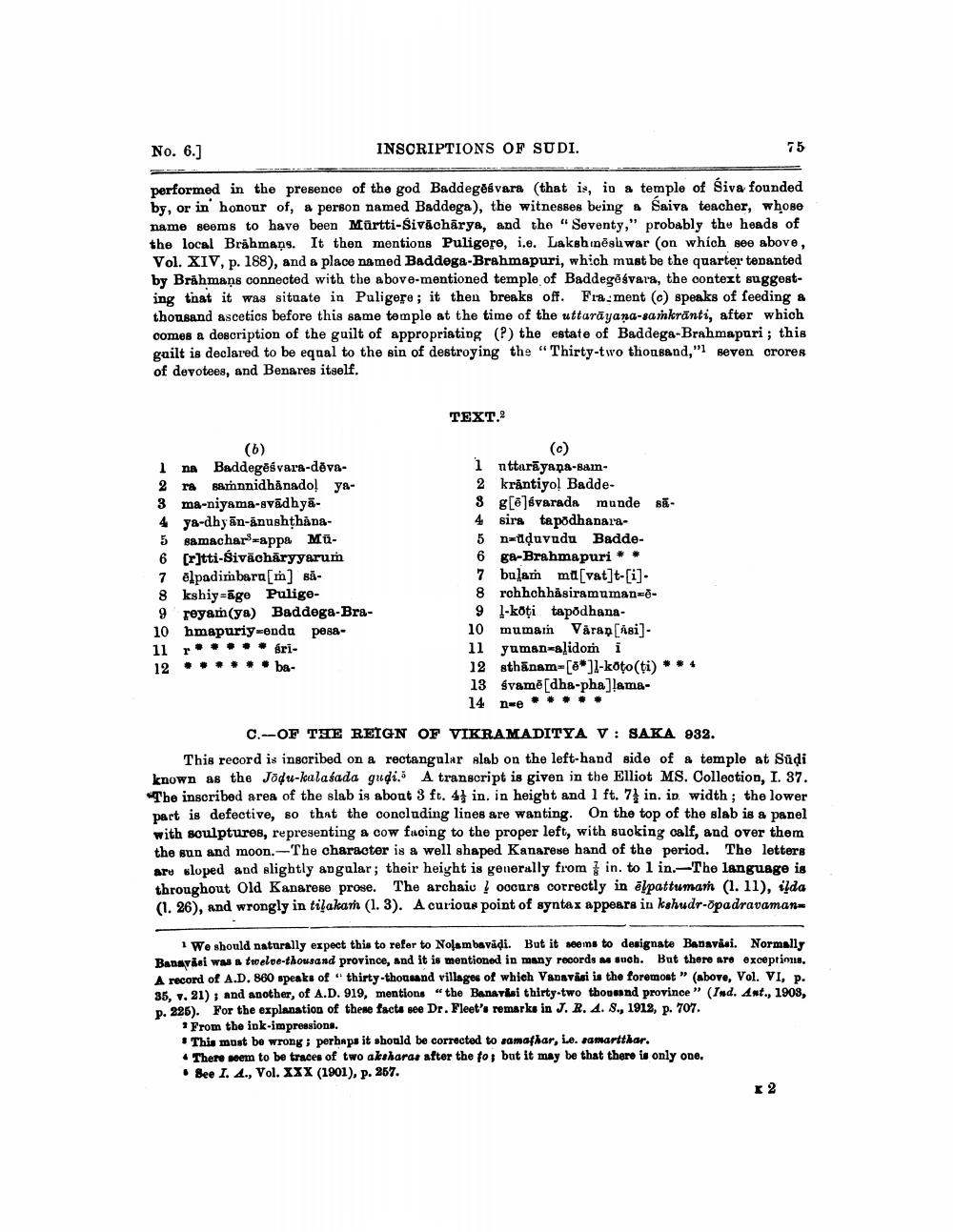________________
No. 6.]
INSCRIPTIONS OF SUDI.
performed in the presence of the god Baddegesvara (that is, in a temple of Siva founded by, or in honour of, a person named Baddega), the witnesses being a Saiva teacher, whose name seems to have been Mürtti-Sivacharya, and the "Seventy," probably the heads of the local Brahmans. It then mentions Puligere, i.e. Lakshmeshwar (on which see above, Vol. XIV, p. 188), and a place named Baddega-Brahmapuri, which must be the quarter tenanted by Brahmans connected with the above-mentioned temple of Baddegesvara, the context suggesting that it was situate in Puligere; it then breaks off. Fra.ment (c) speaks of feeding a thousand ascetics before this same temple at the time of the uttarayana-samkranti, after which comes a description of the guilt of appropriating (?) the estate of Baddega-Brahmapuri; this guilt is declared to be equal to the sin of destroying the "Thirty-two thousand," seven crores of devotees, and Benares itself.
TEXT.2
(b)
B P
1 na Baddegës vara-děva2 ra samnnidhanado! ya3 ma-niyama-svadhya4 ya-dhyan-anushṭhāna5 samachar-appa Mü6 [r]tti-Sivacharyyarum 7 elpadimbara [m] să8 kshiy-age Pulige9 reyam (ya) Baddega-Bra10 hmapuriy-endu pesa
(c) 1 nttarayana-sam2 krantiyo! Badde3 g[e]svarada munde să4 sira tapodhanara5 n-uḍuvudu Badde6 ga-Brahmapuri * 7 bulam mu[vat]t-[i]8 rchhchhäsiramuman-e9 1-köti tapōdhana10 mumam Varap[si]11 yuman-alidom i 12 sthanam [*]l-kōto (ti) 13 évame [dha-pha]lama14 ne
11 r'
śrī
12
ba
C. OF THE REIGN OF VIKRAMADITYA V SAKA 932.
This record is inscribed on a rectangular slab on the left-hand side of a temple at Sūḍi known as the Jōdu-kalaśada gudi. A transcript is given in the Elliot MS. Collection, I. 37. The inscribed area of the slab is about 3 ft. 4 in. in height and 1 ft. 7 in. in width; the lower part is defective, so that the concluding lines are wanting. On the top of the slab is a panel with sculptures, representing a cow facing to the proper left, with sucking calf, and over them the sun and moon.-The character is a well shaped Kanarese hand of the period. The letters are sloped and slightly angular; their height is generally from in. to 1 in.-The language is throughout Old Kanarese prose. The archaic occurs correctly in elpattumam (1. 11), ilda (1. 26), and wrongly in tilakam (1. 3). A curious point of syntax appears in kshudr-ōpadravaman=
1 We should naturally expect this to refer to Nolambavadi. But it seems to designate Banavisi. Normally Banarasi was a twelve-thousand province, and it is mentioned in many records as such. But there are exceptions. A record of A.D. 860 speaks of thirty-thousand villages of which Vanavasi is the foremost " (above, Vol. VI, p. 35, v. 21); and another, of A.D. 919, mentions "the Banavisi thirty-two thousand province" (Ind. Ant., 1903, p. 225). For the explanation of these facts see Dr. Fleet's remarks in J. R. A. S., 1912, p. 707.
From the ink-impressions.
This must be wrong; perhaps it should be corrected to samathar, ie. samartthar.
75
There seem to be traces of two aksharas after the fo; but it may be that there is only one. See I. 4., Vol. XXX (1901), p. 257.
x 2




